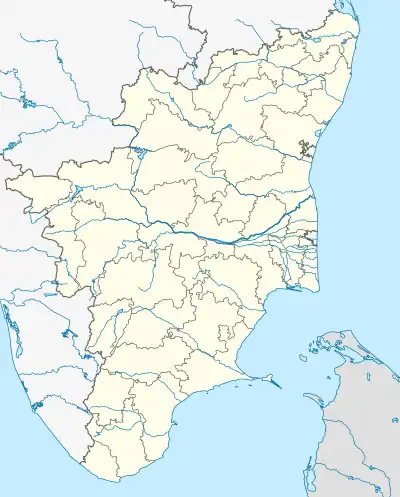Serugudi
Serugudi is a village in the Thiruvidaimarudur taluk of Thanjavur district, Tamil Nadu, India. It is situated between Thiruppanandal and Pandanallur. The nearest bus stop is at Kakithapattarai.
Serugudi | |
|---|---|
village | |
 Serugudi Location in Tamil Nadu, India  Serugudi Serugudi (India) | |
| Coordinates: 10.98°N 79.47°E | |
| Country | |
| State | Tamil Nadu |
| District | Thanjavur |
| Taluk | Thiruvidaimarudur |
| Government | |
| • Body | Serugudi Village Panchayat |
| Population (2001) | |
| • Total | 1,118 |
| Languages | |
| • Official | Tamil |
| Time zone | UTC+5:30 (IST) |
| Nearest city | Tiruchirapalli |
| Sex ratio | 951 ♂/♀ |
| Lok Sabha constituency | Mayiladuthurai |
| Vidhan Sabha constituency | Thiruvidaimarudur |
| Civic agency | Serugudi Village Panchayat |
According to the 2001 census, it had a population of 2,094 with 1070 men and 1024 women. During British rule, the village was a part of Shiyali taluk of Tanjore District.[1] The village is famous for its Ayyanar temple, Virupaksheeswarar Temple and Shitala Amman temple.
History

Serugudi was established by Kulothunga Chola I as a brahmadeya under the name "Solakulavalli chaturvedimangalam" at the behest of his queen Solakulavalli.[2] Kulothunga Chola I invited Brahmins from conquered lands to settle in the village and gave large gifts of land to them.[2] The Virupaksheeswarar temple at Serugudi was constructed by Rajaraja Chola II in about 1160 AD.[2] A 12th century inscription found on a wall adjoining the Dakshinamoorthi shrine in the temple complex records the grant and mentions the name of the village as "Thannaru" and the name of the deity as "Thannarudaya Nayanar".[2] The stone and mortar temple was built upon an older brick shrine centred on a vilva tree.[2] Rajaraja Chola II is also credited with the founding of a nearby shrine dedicated to Sithala Devi.[2] Serugudi was also alternatively known as "Virupakshipuram".[2]
The Virupaksheeswarar Temple was renovated and consecrated by Chandrashekarendra Saraswati, the Shankaracharya of Kanchi matha in 1949.[2]
 Ayyanar temple in Serugudi
Ayyanar temple in Serugudi
References
- Alphabetical list of villages in taluks and districts of Madras Presidency. 1930. p. 605.
- Official History of the Virupaksheeswarar Temple by R. Nagaswami, Virupaksheeswarar Temple Notice Board